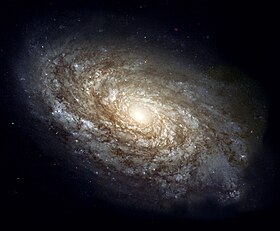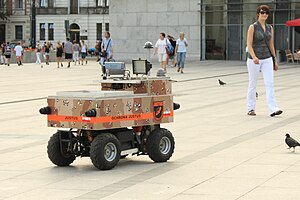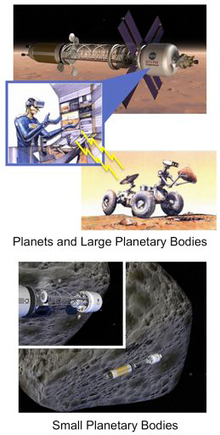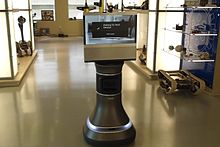From Wikipedia, the free encyclopedia
Astrochemistry is the study of the abundance and reactions of chemical elements and molecules in the universe, and their interaction with radiation.[citation needed] The discipline is an overlap of astronomy and chemistry. The word "astrochemistry" may be applied to both the Solar System and the interstellar medium. The study of the abundance of elements and isotope ratios in Solar System objects, such as meteorites, is also called cosmochemistry, while the study of interstellar atoms and molecules and their interaction with radiation is sometimes called molecular astrophysics. The formation, atomic and chemical composition, evolution and fate of molecular gas clouds is of special interest, because it is from these clouds that solar systems form.
Perhaps the most powerful technique for detection of individual chemical species is radio astronomy, which has resulted in the detection of over a hundred interstellar species, including radicals and ions, and organic (i.e. carbon-based) compounds, such as alcohols, acids, aldehydes, and ketones. One of the most abundant interstellar molecules, and among the easiest to detect with radio waves (due to its strong electric dipole moment), is CO (carbon monoxide). In fact, CO is such a common interstellar molecule that it is used to map out molecular regions.[1] The radio observation of perhaps greatest human interest is the claim of interstellar glycine,[2] the simplest amino acid, but with considerable accompanying controversy.[3] One of the reasons why this detection was controversial is that although radio (and some other methods like rotational spectroscopy) are good for the identification of simple species with large dipole moments, they are less sensitive to more complex molecules, even something relatively small like amino acids.
Moreover, such methods are completely blind to molecules that have no dipole. For example, by far the most common molecule in the universe is H2 (hydrogen gas), but it does not have a dipole moment, so it is invisible to radio telescopes. Moreover, such methods cannot detect species that are not in the gas-phase. Since dense molecular clouds are very cold (10-50 K = -263 to -223 C = -440 to -370 F), most molecules in them (other than hydrogen) are frozen, i.e. solid. Instead, hydrogen and these other molecules are detected using other wavelengths of light. Hydrogen is easily detected in the ultraviolet (UV) and visible ranges from its absorption and emission of light (the hydrogen line). Moreover, most organic compounds absorb and emit light in the infrared (IR) so, for example, the detection of methane in the atmosphere of Mars[4] was achieved using an IR ground-based telescope, NASA's 3-meter Infrared Telescope Facility atop Mauna Kea, Hawaii. NASA also has an airborne IR telescope called SOFIA and an IR space telescope called Spitzer. Somewhat related to the recent detection of methane in the atmosphere of Mars, scientists reported, in June 2012, that measuring the ratio of hydrogen and methane levels on Mars may help determine the likelihood of life on Mars.[5][6] According to the scientists, "...low H2/CH4 ratios (less than approximately 40) indicate that life is likely present and active."[5] Other scientists have recently reported methods of detecting hydrogen and methane in extraterrestrial atmospheres.[7][8]
Infrared astronomy has also revealed that the interstellar medium contains a suite of complex gas-phase carbon compounds called polyaromatic hydrocarbons, often abbreviated PAHs or PACs. These molecules, composed primarily of fused rings of carbon (either neutral or in an ionized state), are said to be the most common class of carbon compound in the galaxy. They are also the most common class of carbon molecule in meteorites and in cometary and asteroidal dust (cosmic dust). These compounds, as well as the amino acids, nucleobases, and many other compounds in meteorites, carry deuterium and isotopes of carbon, nitrogen, and oxygen that are very rare on earth, attesting to their extraterrestrial origin. The PAHs are thought to form in hot circumstellar environments (around dying, carbon-rich red giant stars).
Infrared astronomy has also been used to assess the composition of solid materials in the interstellar medium, including silicates, kerogen-like carbon-rich solids, and ices. This is because unlike visible light, which is scattered or absorbed by solid particles, the IR radiation can pass through the microscopic interstellar particles, but in the process there are absorptions at certain wavelengths that are characteristic of the composition of the grains.[9] As above with radio astronomy, there are certain limitations, e.g. N2 is difficult to detect by either IR or radio astronomy.
Such IR observations have determined that in dense clouds (where there are enough particles to attenuate the destructive UV radiation) thin ice layers coat the microscopic particles, permitting some low-temperature chemistry to occur. Since hydrogen is by far the most abundant molecule in the universe, the initial chemistry of these ices is determined by the chemistry of the hydrogen. If the hydrogen is atomic, then the H atoms react with available O, C and N atoms, producing "reduced" species like H2O, CH4, and NH3. However, if the hydrogen is molecular and thus not reactive, this permits the heavier atoms to react or remain bonded together, producing CO, CO2, CN, etc. These mixed-molecular ices are exposed to ultraviolet radiation and cosmic rays, which results in complex radiation-driven chemistry.[9] Lab experiments on the photochemistry of simple interstellar ices have produced amino acids.[10] The similarity between interstellar and cometary ices (as well as comparisons of gas phase compounds) have been invoked as indicators of a connection between interstellar and cometary chemistry. This is somewhat supported by the results of the analysis of the organics from the comet samples returned by the Stardust mission but the minerals also indicated a surprising contribution from high-temperature chemistry in the solar nebula.
The sparseness of interstellar and interplanetary space results in some unusual chemistry, since symmetry-forbidden reactions cannot occur except on the longest of timescales. For this reason, molecules and molecular ions which are unstable on Earth can be highly abundant in space, for example the H3+ ion. Astrochemistry overlaps with astrophysics and nuclear physics in characterizing the nuclear reactions which occur in stars, the consequences for stellar evolution, as well as stellar 'generations'. Indeed, the nuclear reactions in stars produce every naturally occurring chemical element. As the stellar 'generations' advance, the mass of the newly formed elements increases. A first-generation star uses elemental hydrogen (H) as a fuel source and produces helium (He). Hydrogen is the most abundant element, and it is the basic building block for all other elements as its nucleus has only one proton. Gravitational pull toward the center of a star creates massive amounts of heat and pressure, which cause nuclear fusion. Through this process of merging nuclear mass, heavier elements are formed. Carbon, oxygen and silicon are examples of elements that form in stellar fusion. After many stellar generations, very heavy elements are formed (e.g. iron and lead).
In October 2011, scientists reported that cosmic dust contains complex organic matter ("amorphous organic solids with a mixed aromatic-aliphatic structure") that could be created naturally, and rapidly, by stars.[11][12][13]
On August 29, 2012, and in a world first, astronomers at Copenhagen University reported the detection of a specific sugar molecule, glycolaldehyde, in a distant star system. The molecule was found around the protostellar binary IRAS 16293-2422, which is located 400 light years from Earth.[14][15] Glycolaldehyde is needed to form ribonucleic acid, or RNA, which is similar in function to DNA. This finding suggests that complex organic molecules may form in stellar systems prior to the formation of planets, eventually arriving on young planets early in their formation.[16]
In September, 2012, NASA scientists reported that polycyclic aromatic hydrocarbons (PAHs), subjected to interstellar medium (ISM) conditions, are transformed, through hydrogenation, oxygenation and hydroxylation, to more complex organics - "a step along the path toward amino acids and nucleotides, the raw materials of proteins and DNA, respectively".[17][18] Further, as a result of these transformations, the PAHs lose their spectroscopic signature which could be one of the reasons "for the lack of PAH detection in interstellar ice grains, particularly the outer regions of cold, dense clouds or the upper molecular layers of protoplanetary disks."[17][18]
In February 2014, NASA announced the creation of an improved spectral database [19] for tracking polycyclic aromatic hydrocarbons (PAHs) in the universe. According to scientists, more than 20% of the carbon in the universe may be associated with PAHs, possible starting materials for the formation of life. PAHs seem to have been formed shortly after the Big Bang, are widespread throughout the universe, and are associated with new stars and exoplanets.[20]
On August 11, 2014, astronomers released studies, using the Atacama Large Millimeter/Submillimeter Array (ALMA) for the first time, that detailed the distribution of HCN, HNC, H2CO, and dust inside the comae of comets C/2012 F6 (Lemmon) and C/2012 S1 (ISON).[21][22]
For the study of the recourses of chemical elements and molecules in the universe is developed the mathematical model of the molecules composition distribution in the interstellar environment on thermodynamic potentials by professor M.Yu. Dolomatov using methods of the probability theory, the mathematical and physical statistics and the equilibrium thermodynamics.[23][24][25] Based on this model are estimated the resources of life-related molecules, amino acids and the nitrogenous bases in the interstellar medium. The possibility of the oil hydrocarbons molecules formation is shown. The given calculations confirm Sokolov’s and Hoyl’s hypotheses about the possibility of the oil hydrocarbons formation in Space. Results are confirmed by data of astrophysical supervision and space researches.
Spectroscopy
One particularly important experimental tool in astrochemistry is spectroscopy, the use of telescopes to measure the absorption and emission of light from molecules and atoms in various environments. By comparing astronomical observations with laboratory measurements, astrochemists can infer the elemental abundances, chemical composition, and temperatures of stars and interstellar clouds. This is possible because ions, atoms, and molecules have characteristic spectra: that is, the absorption and emission of certain wavelengths (colors) of light, often not visible to the human eye. However, these measurements have limitations, with various types of radiation (radio, infrared, visible, ultraviolet etc.) able to detect only certain types of species, depending on the chemical properties of the molecules. Interstellar formaldehyde was the first organic molecule detected in the interstellar medium.Perhaps the most powerful technique for detection of individual chemical species is radio astronomy, which has resulted in the detection of over a hundred interstellar species, including radicals and ions, and organic (i.e. carbon-based) compounds, such as alcohols, acids, aldehydes, and ketones. One of the most abundant interstellar molecules, and among the easiest to detect with radio waves (due to its strong electric dipole moment), is CO (carbon monoxide). In fact, CO is such a common interstellar molecule that it is used to map out molecular regions.[1] The radio observation of perhaps greatest human interest is the claim of interstellar glycine,[2] the simplest amino acid, but with considerable accompanying controversy.[3] One of the reasons why this detection was controversial is that although radio (and some other methods like rotational spectroscopy) are good for the identification of simple species with large dipole moments, they are less sensitive to more complex molecules, even something relatively small like amino acids.
Moreover, such methods are completely blind to molecules that have no dipole. For example, by far the most common molecule in the universe is H2 (hydrogen gas), but it does not have a dipole moment, so it is invisible to radio telescopes. Moreover, such methods cannot detect species that are not in the gas-phase. Since dense molecular clouds are very cold (10-50 K = -263 to -223 C = -440 to -370 F), most molecules in them (other than hydrogen) are frozen, i.e. solid. Instead, hydrogen and these other molecules are detected using other wavelengths of light. Hydrogen is easily detected in the ultraviolet (UV) and visible ranges from its absorption and emission of light (the hydrogen line). Moreover, most organic compounds absorb and emit light in the infrared (IR) so, for example, the detection of methane in the atmosphere of Mars[4] was achieved using an IR ground-based telescope, NASA's 3-meter Infrared Telescope Facility atop Mauna Kea, Hawaii. NASA also has an airborne IR telescope called SOFIA and an IR space telescope called Spitzer. Somewhat related to the recent detection of methane in the atmosphere of Mars, scientists reported, in June 2012, that measuring the ratio of hydrogen and methane levels on Mars may help determine the likelihood of life on Mars.[5][6] According to the scientists, "...low H2/CH4 ratios (less than approximately 40) indicate that life is likely present and active."[5] Other scientists have recently reported methods of detecting hydrogen and methane in extraterrestrial atmospheres.[7][8]
Infrared astronomy has also revealed that the interstellar medium contains a suite of complex gas-phase carbon compounds called polyaromatic hydrocarbons, often abbreviated PAHs or PACs. These molecules, composed primarily of fused rings of carbon (either neutral or in an ionized state), are said to be the most common class of carbon compound in the galaxy. They are also the most common class of carbon molecule in meteorites and in cometary and asteroidal dust (cosmic dust). These compounds, as well as the amino acids, nucleobases, and many other compounds in meteorites, carry deuterium and isotopes of carbon, nitrogen, and oxygen that are very rare on earth, attesting to their extraterrestrial origin. The PAHs are thought to form in hot circumstellar environments (around dying, carbon-rich red giant stars).
Infrared astronomy has also been used to assess the composition of solid materials in the interstellar medium, including silicates, kerogen-like carbon-rich solids, and ices. This is because unlike visible light, which is scattered or absorbed by solid particles, the IR radiation can pass through the microscopic interstellar particles, but in the process there are absorptions at certain wavelengths that are characteristic of the composition of the grains.[9] As above with radio astronomy, there are certain limitations, e.g. N2 is difficult to detect by either IR or radio astronomy.
Such IR observations have determined that in dense clouds (where there are enough particles to attenuate the destructive UV radiation) thin ice layers coat the microscopic particles, permitting some low-temperature chemistry to occur. Since hydrogen is by far the most abundant molecule in the universe, the initial chemistry of these ices is determined by the chemistry of the hydrogen. If the hydrogen is atomic, then the H atoms react with available O, C and N atoms, producing "reduced" species like H2O, CH4, and NH3. However, if the hydrogen is molecular and thus not reactive, this permits the heavier atoms to react or remain bonded together, producing CO, CO2, CN, etc. These mixed-molecular ices are exposed to ultraviolet radiation and cosmic rays, which results in complex radiation-driven chemistry.[9] Lab experiments on the photochemistry of simple interstellar ices have produced amino acids.[10] The similarity between interstellar and cometary ices (as well as comparisons of gas phase compounds) have been invoked as indicators of a connection between interstellar and cometary chemistry. This is somewhat supported by the results of the analysis of the organics from the comet samples returned by the Stardust mission but the minerals also indicated a surprising contribution from high-temperature chemistry in the solar nebula.
Research
Research is progressing on the way in which interstellar and circumstellar molecules form and interact, and this research could have a profound impact on our understanding of the suite of molecules that were present in the molecular cloud when our solar system formed, which contributed to the rich carbon chemistry of comets and asteroids and hence the meteorites and interstellar dust particles which fall to the Earth by the ton every day.The sparseness of interstellar and interplanetary space results in some unusual chemistry, since symmetry-forbidden reactions cannot occur except on the longest of timescales. For this reason, molecules and molecular ions which are unstable on Earth can be highly abundant in space, for example the H3+ ion. Astrochemistry overlaps with astrophysics and nuclear physics in characterizing the nuclear reactions which occur in stars, the consequences for stellar evolution, as well as stellar 'generations'. Indeed, the nuclear reactions in stars produce every naturally occurring chemical element. As the stellar 'generations' advance, the mass of the newly formed elements increases. A first-generation star uses elemental hydrogen (H) as a fuel source and produces helium (He). Hydrogen is the most abundant element, and it is the basic building block for all other elements as its nucleus has only one proton. Gravitational pull toward the center of a star creates massive amounts of heat and pressure, which cause nuclear fusion. Through this process of merging nuclear mass, heavier elements are formed. Carbon, oxygen and silicon are examples of elements that form in stellar fusion. After many stellar generations, very heavy elements are formed (e.g. iron and lead).
In October 2011, scientists reported that cosmic dust contains complex organic matter ("amorphous organic solids with a mixed aromatic-aliphatic structure") that could be created naturally, and rapidly, by stars.[11][12][13]
On August 29, 2012, and in a world first, astronomers at Copenhagen University reported the detection of a specific sugar molecule, glycolaldehyde, in a distant star system. The molecule was found around the protostellar binary IRAS 16293-2422, which is located 400 light years from Earth.[14][15] Glycolaldehyde is needed to form ribonucleic acid, or RNA, which is similar in function to DNA. This finding suggests that complex organic molecules may form in stellar systems prior to the formation of planets, eventually arriving on young planets early in their formation.[16]
In September, 2012, NASA scientists reported that polycyclic aromatic hydrocarbons (PAHs), subjected to interstellar medium (ISM) conditions, are transformed, through hydrogenation, oxygenation and hydroxylation, to more complex organics - "a step along the path toward amino acids and nucleotides, the raw materials of proteins and DNA, respectively".[17][18] Further, as a result of these transformations, the PAHs lose their spectroscopic signature which could be one of the reasons "for the lack of PAH detection in interstellar ice grains, particularly the outer regions of cold, dense clouds or the upper molecular layers of protoplanetary disks."[17][18]
In February 2014, NASA announced the creation of an improved spectral database [19] for tracking polycyclic aromatic hydrocarbons (PAHs) in the universe. According to scientists, more than 20% of the carbon in the universe may be associated with PAHs, possible starting materials for the formation of life. PAHs seem to have been formed shortly after the Big Bang, are widespread throughout the universe, and are associated with new stars and exoplanets.[20]
On August 11, 2014, astronomers released studies, using the Atacama Large Millimeter/Submillimeter Array (ALMA) for the first time, that detailed the distribution of HCN, HNC, H2CO, and dust inside the comae of comets C/2012 F6 (Lemmon) and C/2012 S1 (ISON).[21][22]
For the study of the recourses of chemical elements and molecules in the universe is developed the mathematical model of the molecules composition distribution in the interstellar environment on thermodynamic potentials by professor M.Yu. Dolomatov using methods of the probability theory, the mathematical and physical statistics and the equilibrium thermodynamics.[23][24][25] Based on this model are estimated the resources of life-related molecules, amino acids and the nitrogenous bases in the interstellar medium. The possibility of the oil hydrocarbons molecules formation is shown. The given calculations confirm Sokolov’s and Hoyl’s hypotheses about the possibility of the oil hydrocarbons formation in Space. Results are confirmed by data of astrophysical supervision and space researches.







